Ijen is an active volcano in eastern Java that spits sulfur gases which ignite on contact with the air creating blue fires, a phenomenon that can be seen only at night. The blue fires are unique as these are the largest phenomenon of this kind in the world.
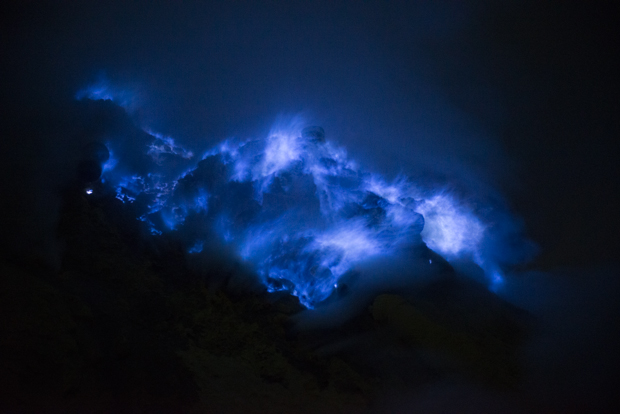
After day long preparation mostly by seeping late we set out at around midnight form Banyuwangi, an eastern coastal town in Java. The motorbike ride took us an hour and was an experience in itself as the road was totally empty once we passed the villages close to Banyuwangi. It was a lightly overcast bright night due to it being close to full moon which made our climb up the mountain even more enjoyable. The road and surrounding forest was illuminated as if by streetlight. We reached the starting point of the trek and were one of the first tourists to arrive with an aim of pulling through the night until the sunrise.
We were made to pay an entrance fee of IDR 100,000 which has increased from IDR 15,000 on August 1st 2014 and were on our way up the Ijen crater rim. There is no guide required nor is one necessary for the ascend as the path is wide and clearly recognizable either in a moonlight or with an aid of a torch that’s a must-have on a trip like that. At the beginning of the trail we were joined by one of the sulfur miners that spoke little English and was missing few teeth. He joined us for the beginning of the trip to gauge if we needed or were willing to pay for a guide. We have politely declined both in English and broken Indonesian that matched his English and he went on to inquire with other people about the same thing.
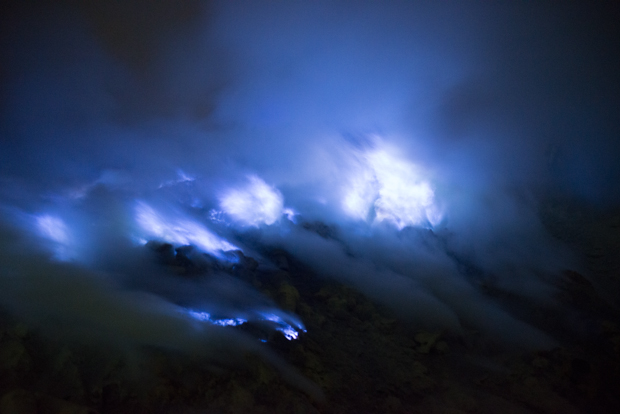
We have heard stories of sulfur miners being underpaid for what is undoubtedly a dangerous job that leaves a permanent mark on their health. Nowadays it seems that some of them are waiting for the first tourists to hit the trail to offer them their guiding services to draw some extra income. We preferred our own company for the ascend to the rim that is 3 km long first 1.3km of which is quite easy with the remaining 1.7 km being quite steep so you may feel a little sweat on your back, but isn’t it what reaching the summit is all about. We are not particularly fit but didn’t find the trek particularly challenging, but again this is may be relative. Also note that the difficulty increases if the trail is wet as it may get very slippery so do not forget to bring good trekking shoes.
It took about 90 minutes to reach the viewing spot where we found few tourists crowding already along with some of the miners blocking the way down to the crater. We hear that you may skip taking the guide, but from our experience you would either have to engage in physical conflict with miners blocking the entrance or wait for the main tourist wave and blend in with one of the groups that actually came with a guide. We opted for negotiating the price down to IDR 30,000 and went on down into the crater of an active volcano to see the blue flames up close.
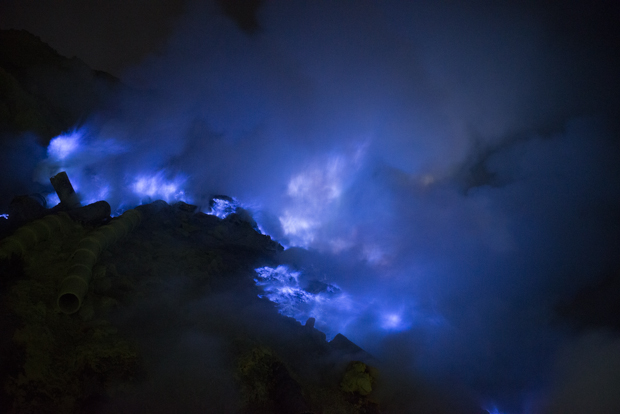
Soon we realized that hiring the miner/guide was a good idea. The 300 m deep crater can be a challenge to descend into especially when you are one of the first ones to get down there. The gradient exceeds 45 degrees in places and even thought the miners made the path to get to the sulfur extraction point, it is not always obvious and a wrong choice can really cost you your life. Be very careful when going down as some of the rocks are loose and others covered with sulfur dust can be extremely slippery. I would not venture down at all if it was raining. If you prefer to wait for the main wave of tourists the descend is going to be much easier as there is going to be a human chain literally illuminating the way down for you, yet whether it is safer to do it with them is debatable with hundred or so people crowding down a narrow steep trail.
Anyhow once you reach the bottom a truly amazing sight awaits you provided that you can bear an immense stench of sulfur that will irritate your lungs and eyes and can be really dangerous especially when you get caught in a sulfur cloud that gets out of the crater every few minutes. It is not a place for people with asthma and a proper gas mask is very reasonable piece of kit to take with you if you are planning get down into the crater. Like everything it is a matter of opinion, but I found the intense blue fire dancing on the rocks and spilling over them as the gas liquefies a sufficient reward for risking breaking my neck on the way down and nearly suffocating when trying to wait out the sulfur cloud to take a good shot of the flames.
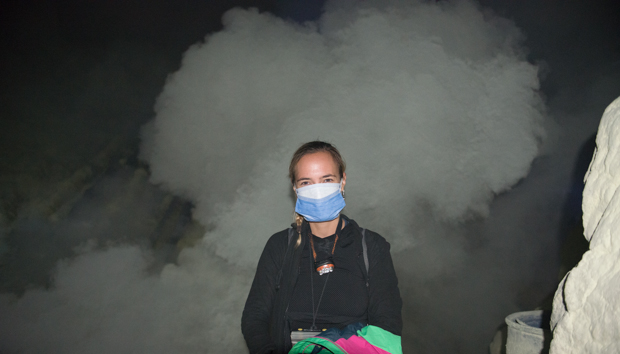
You can watch miners getting dangerously close to the flames that reach 600 degrees Celsius to extract sulfur usually by chopping chunks of it with nothing more than a metal rod, often having nothing more than a piece of cloth for a gas mask. Once chopped off the sulfur cools down quickly and losses its red color and flexibility becoming yellow and fragile. The miners who can carry up to 90kg of sulfur up the crater and down to the car park, constructed several ceramic pipes to channel sulfur to a more accessible place for extraction which still seems ridiculously close to the flames and toxic fumes.
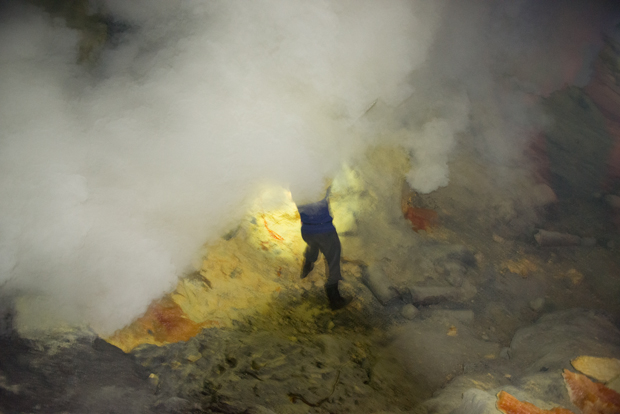
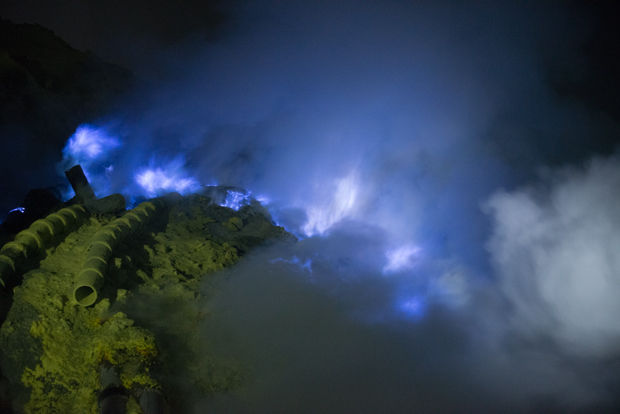
The operation of mining sulfur does not look as dangerous as it is when you look at the causal manner sulfur miners go about their business and the number of tourists making the trip into Kawah Ijen crater. One needs to remember though about long term effects of inhaling sulfur gasses and the unpredictable nature of active volcanoes especially after recent eruption of Mount Unzen in Japan. Ijen is an active volcano and about 35 years ago it showed its deadly nature. There was an underwater eruption that momentarily increased Ijen crater lake water level. The gasses that were eventually released killed about a dozen people who were inside the crater at that moment. It is something that one needs to consider when going down an active volcano crater.
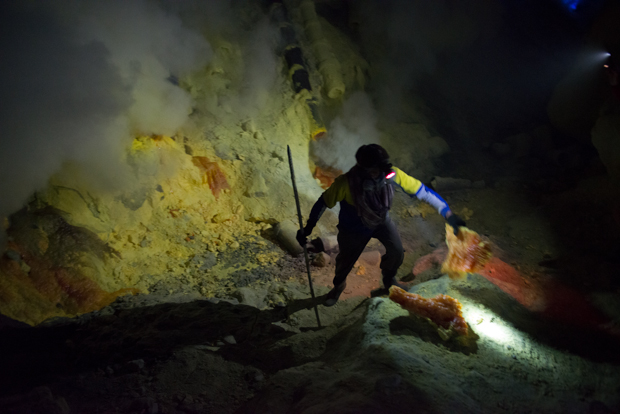
Once we had enjoyed Ijen blue fires enough we decided to go back up just in time to make it for the sunrise on the rim. It was still completely dark when we started our ascend, but the path we sometimes dreaded on our way down did not look that scary anymore thanks to a number of latecomers that were lighting our way up with their head torches. We have paid our guide and decided to head up the light chain quickly as he was carrying some serious load of sulfur from his spear wielding sulfur mining operation.
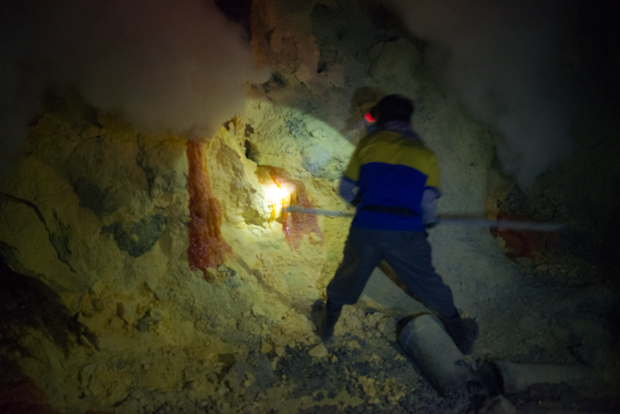
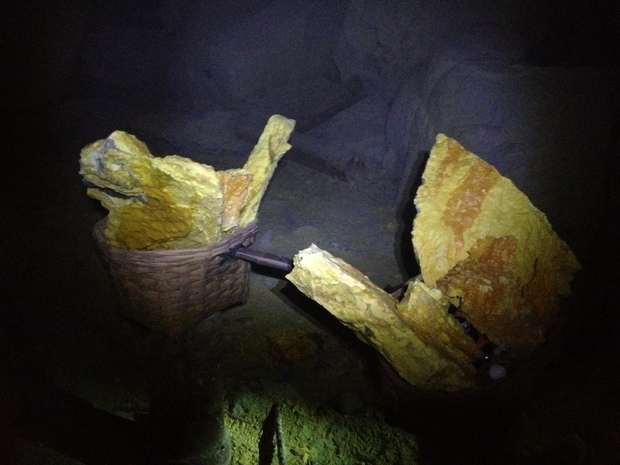
When we got back to the entry point into the Ijen crater there were already many people waiting for the sunset, but we decided to reach the highest point of the volcano crater rim. The path that will take you up is initially not obvious apart from the general direction. Up! It gives you a few options to meander in channels made of cool magma or maybe cracks in crust of the rim for a few minutes and then narrows down, but is clearly identifiable for most of the way. It will lead sometimes directly at the very rim of the crater through the bushes that grow there. The path will take you to the wider part of the rim from where you can enjoy the sunrise.
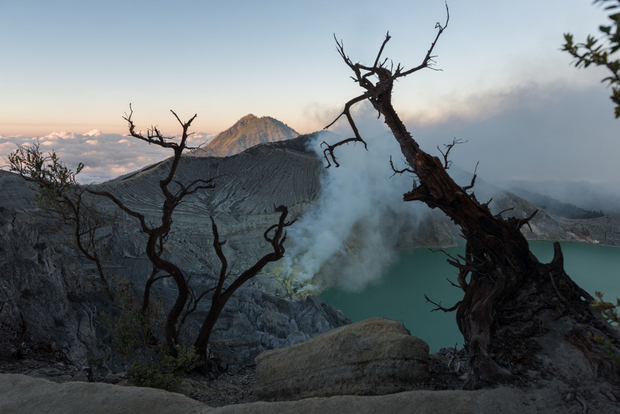
You can see the whole lake of Kawah Ijen from along the steep almost vertical drop into the crater and a way easier slope down the volcano cone on the other side where the sun rises. The view from there is simply amazing! When you look at the Ijen acidic lake and see the tiny fuming part on its left where you can enjoy the blue flames at night, the size of the crater becomes apparent. There is a higher part of the mountain that is not directly at the crater rim that can cast beautiful shadow over large part of the sky when you watch the sunrise.
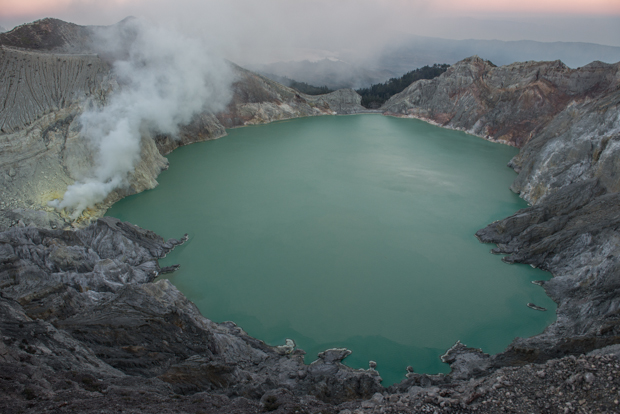
There were not too many people up there as most of the crowd stayed at the lower point of the rim near the start of the path down the crater. Since we had our own transportation we stuck around until everyone else was gone. The dusty, windy place above the clouds was entirely ours for this little while. When we looked at the crater lake we noticed that while the sun was rising we started to cast shadows on the lake surface from 500 meters above. We played with this effect like children doing different silly poses that made us laugh and added to an amazing morning we were having.
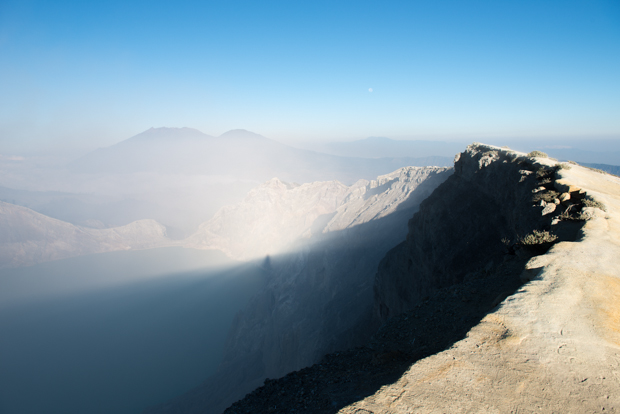
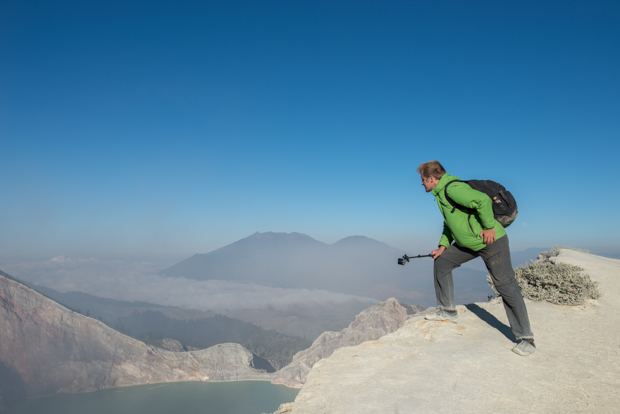
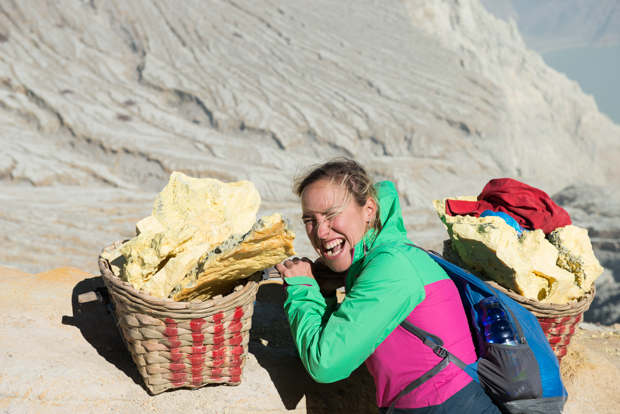
On the way down we have enjoyed beautiful mountain vistas in different light setting. When we ascended at night the surrounding area was lit by the moonlight and this sunny morning made us experience the place again as if it was a different one. All in all Kawah Ijen is an amazing place even though there is a considerable number of tourists visiting it already. Especially dusty and windy rim up top made it for a bit of an unearthly experience.

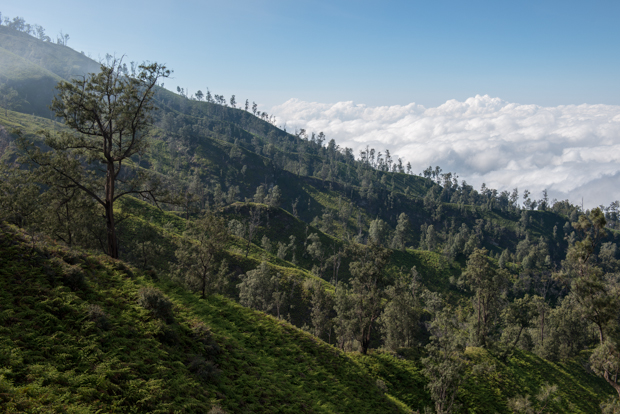
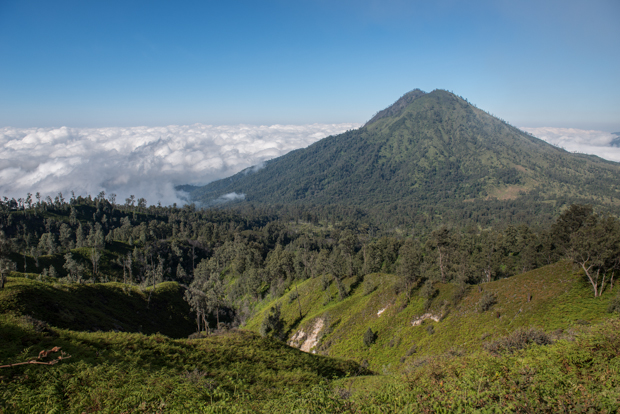
TIPS:
• Most tours start between 1.00 and 1.30am so if you want to avoid the traffic on the road and up the mountain go earlier.
• There are a few guesthouses close to the volcano or you can stay in Banyuwangi which has a bigger selection of hotels in a decent price range but you have to travel longer distance.
• you can find a hideaway place and with luck there will be a fireplace, where you can warm up and stay out of the cold and wind. It’s located on the opposite side to the entry point into the Jien crater. See photo below.
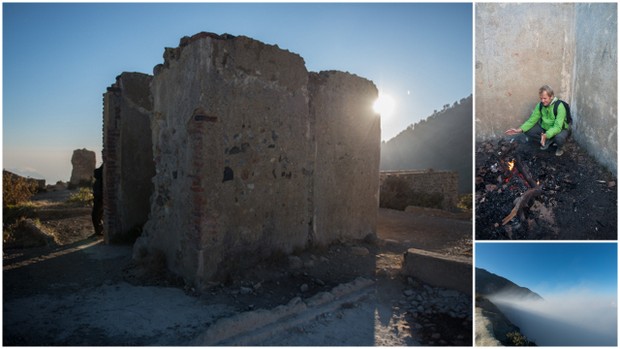
• Take proper hiking shoes, warm clothes, a gas mask and a head torch. (We saw people wearing winter jackets and winter hats even … though not mandatory. A good windproof jacket with a hoodie, a long sleeve blouse and long pants with long socks should suffice.)
• In the parking lot and in the midway up the volcano there is a small ‘cafeteria’ which sells snacks and tea or coffee. The one midway the trail may be closed at night.
• If you are getting there by motorbike at night it’s a good idea to wear gloves as it gets really cold the higher you are. As we didn’t have gloves we used socks and they did the job!
ENJOY !
To see more photos click on this link Blue Fires of Ijen Gallery.
This looks like an amazing place to visit. Blue fires look unreal.